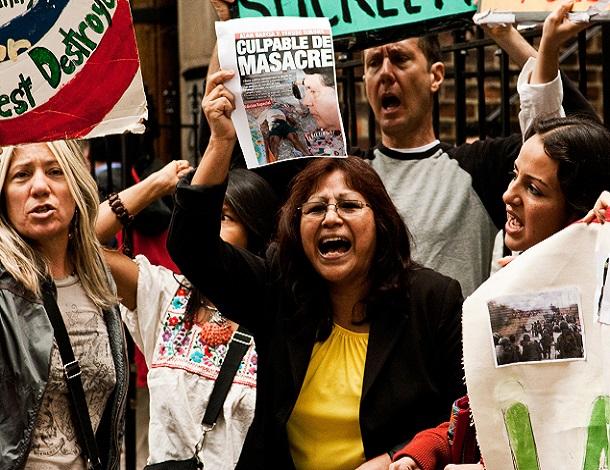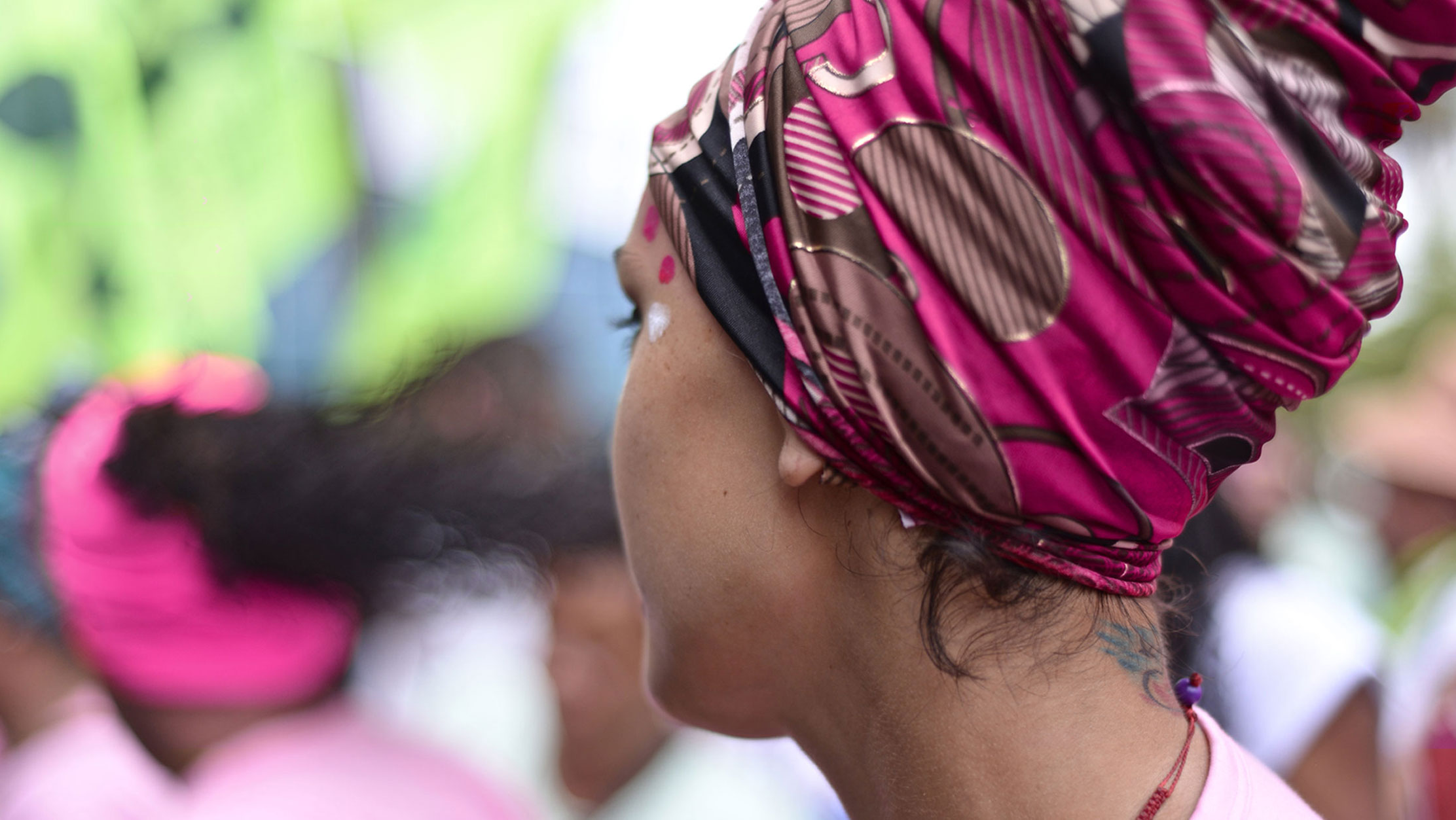FRIDAY FILE: AWID spoke with Lucinda O’Hanlon, Adviser on Women's Rights from the Women's Rights and Gender Section of the Office of the United Nations High Commissioner for Human Rights (OHCHR) about the office’s current Campaign “Beijing + 20: Women Human Rights Defenders Campaign”.
The OHCHR mandate is to “ promote and protect the enjoyment and full realization, by all people, of all rights established in the Charter of the United Nations and in international human rights laws and treaties.”[1] Within this mandate the Women's Rights and Gender Section wanted to commemorate the upcoming 20th Anniversary of the adoption of the Beijing Platform for Action (BpA) with a Campaign focused on the work carried out by Women Human Rights Defenders (WHRDs)[2].
What is the inspiration behind the “Beijing + 20: Women Human Rights Defenders Campaign”?
The High Commissioner for Human Rights Zeid Ra'ad Al Hussein stated that, while we have seen progress in many areas in the 20 years since the adoption of the BpA, we still have a long way to go in addressing the remaining challenges to achieve gender equality. WHRDs were crucial actors in developing the ambitious program set out in Beijing and are key actors in securing that plan.[3]
According to Lucinda O’Hanlon, “We thought that we needed to be shining the light on the defenders who are working across all of the areas of concern of Beijing as they are doing this work risking their own lives and their families… to defend human rights”. She adds, it is a way of honouring the tremendous work done by WHRDs both in Beijing 20 years ago to articulate the blueprint for women’s rights, and since then to defend this agenda.

As the High Commissioner has acknowledged, it is important to highlight the distinct risks and differentiated violence that WHRDs face because of who they are and the work they do. The increase in research and documentation on the work of WHRDs has shown that violence takes different forms from those experienced by their male counterparts. We have been able to document that violence against WHRDs may be gendered or sexualized as a way to “recast women back into their ‘traditional’ roles.” For example, attacks against WHRDs often take gender specific forms, including gendered verbal abuse based on their sex, sexual abuse and rape. [4]
In addition to this, there are many other attacks that are linked to the use of gender and sexual stereotypes to harm WHRDs’ reputation and delegitimize their work. As we have seen in many instances, attacks against WHRDs include attacks against their children and other family members as a way to “encourage” WHRDs to refrain doing their work.[5]
This reality has also been observed and pointed out by the High Commissioner who stated that “these defenders will not be silenced, and we must stand in solidarity with them against these cowardly attacks”. With the increased levels of violence and discrimination that WHRDs face around the globe, now is important to give support and visibility to the WHRDs who operate in increasingly risky contexts and rampant impunity.
Giving visibility and recognition to the work WHRDs do is also an important step towards creating a safe environment and holistic protection mechanisms that allow them to continue their legitimate work.
The Campaign
The “Beijing + 20: Women Human Rights Defenders Campaign” was launched on International Human Rights day on December 10, 2014 and will end on the International Women’s Day on March 8, 2015.
The campaign is organized in two components – firstly the release of a series of short videos profiling WHRDs working around the 12 components of the BpA, showcasing individual WHRDs illustrating the types of work they carry out and the risks they face while doing that work. Giving visibility to this is a way of giving women defenders power and therefore to bringing attention to the existing situation of WHRDs.
Secondly, a social media component aims to attract the general public to generate support and encourage all people to identify themselves as defenders of women’s rights. The underlying idea is that, “being a defender can mean extraordinary acts and risks, and it can mean every day actions to promote gender equality like speaking out when we see sexual harassment or sexist jokes, teaching our girls and boys about gender equality, supporting political candidates who defend the human rights of women, and challenging gender stereotypes wherever they appear, amongst many other actions”.[6]
This component involves inviting people to send in pictures of themselves (“selfies”) in a mirror reflection. The mirror reflection is intended as way to convey all of us self-reflecting on the actions we take to defend human rights, as well as allude to the broader international reflection on 20 years since Beijing.[7]
Sensitizing people around the work WHRDs carry out in contexts of rampant impunity and extreme violence, through reflecting their own actions on promoting gender equality, could have multiplier effects in our homes, workplaces and communities in promoting gender equality and showing solidarity and support to WHRDs working in such contexts.
What is the intended outcome?
O’Hanlon mentions three different levels of impact, recognizing that this is just a start and of the ongoing work to protect, support the work and security of WHRDs.
The Campaign is aiming for an “overall increase in awareness of the reality faced by WHRDs in different parts of the world”. The next level is linked and involves putting the work and security of WHRDs clearly on the agenda’s of UN Member Sates, UN agencies and decision makers. O’Hanlon believes that if “defenders names are out there and circulating, hopefully people will think twice about threatening them and ideally there will be more support to establishing better protection mechanisms”
The third level of impact, and related to the internal mandate of the OHCHR within the UN systems, aims at “helping Member States but also the UN System as a whole to take note and start paying attention more specifically to the situation of WHRDs”, according to O’Hanlon. She says, “The campaign is of course complemented by all the work that happens through our OHCHR presence around the world. OHCHR always tries to ensure that we are working actively with WHRDs, this everyday work will certainly continue, and hopefully intensify as a result of the campaign. We will continue working with Member States reminding them of their human rights obligations”.
O’Hanlon also mentions that she hopes the campaign will foster continued collaboration between OHCHR and civil society and support OHCHR’s positive role in facilitating the conversation about WHRDs. It is our hope that this Campaign will bring even more visibility to the outstanding and irreplaceable work carried out by WHRDs to defend the rights of all people in the pursuit of a more just and peaceful world for all.
How can you or your organization support and get involved in the Campaign?
The campaign runs from Human Rights Day, 10 December 2014, to International Women’s Day, 8 March 2015. We encourage everyone to engage and support WHRDs around the world by watching and disseminating the videos during the duration of the Campaign and send the pictures via Twitter with a single message declaring: “I am a women’s human rights defender”, “I am a defender of women’s human rights” and using the hashtag #Reflect2Protect.
--------
For more information about the Campaign you can visit:
http://www.ohchr.org/EN/NewsEvents/WHRD/Pages/WomenHRDefenders.aspx
To access the Call for mirror selfies go to: http://www.awid.org/eng/Library/Beijing-20-Women-Human-Rights-Defenders-Campaign
[1] Office of the High Commissioner for Human Rights, Available at: http://www.ohchr.org/EN/AboutUs/Pages/Mandate.aspx
[2] Women Human Rights Defenders (WHRDs) are women activists who uphold the rights of people, communities, and the environment. WHRDs are women active in human rights defense, as well as men and women active in the defense of women’s rights and the rights of Lesbian, Gay, Transgender, and Intersex (LGBTI) people. See: http://www.awid.org/Library/Learn-More-About-AWID-s-Work-to-Support-and-Protect-Women-Human-Rights-Defenders
[3] Stand in solidarity with courageous women’s human rights defenders. By the United Nations High Commissioner for Human Rights, Zeid Ra’ad Al Hussein, December 1, 2014. Available at: http://beijing20.unwomen.org/en/news-and-events/stories/2014/12/oped-ohchr
[4] Inmaculada Barcia, AWID-WHRD IC, Our Right To Safety: Women Human Rights Defenders’ Holistic Approach to Protection, 2014, p. 9
[5] ibid.
[6] Beijing +20: Women Human Rights Defenders Campaign (WRGS/ROLENDB/RRDD) 10 December 2014 – 8 March 2015 - Call for mirror reflection selfies!
[7] Beijing +20: Women Human Rights Defenders Campaign (WRGS/ROLENDB/RRDD)
10 December 2014 – 8 March 2015 - Call for mirror reflection selfies!
